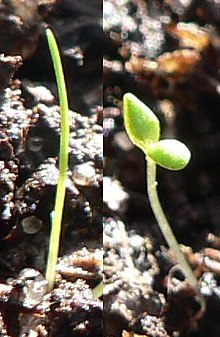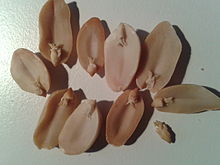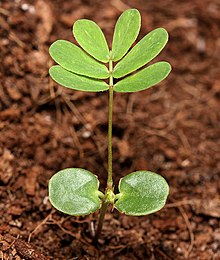
Back فلقة (بذرة) Arabic Cotyledon Azerbaijani Семядоля Byelorussian Kotiledon BS Cotiledó Catalan Děložní lístek Czech Пайвăрă CV Kimblad Danish Kotyledone German Κοτυληδόνα Greek






A cotyledon (/ˌkɒtɪˈliːdən/; from Latin cotyledon;[1] from κοτυληδών (kotulēdṓn) "a cavity, small cup, any cup-shaped hollow",[2] gen. κοτυληδόνος (kotulēdónos), from κοτύλη (kotýlē) 'cup, bowl') is a "seed leaf" - a significant part of the embryo within the seed of a plant, and is formally defined as "the embryonic leaf in seed-bearing plants, one or more of which are the first to appear from a germinating seed."[3] Botanists use the number of cotyledons present as one characteristic to classify the flowering plants (angiosperms): species with one cotyledon are called monocotyledonous ("monocots"); plants with two embryonic leaves are termed dicotyledonous ("dicots").
In the case of dicot seedlings whose cotyledons are photosynthetic, the cotyledons are functionally similar to leaves. However, true leaves and cotyledons are developmentally distinct. Cotyledons form during embryogenesis, along with the root and shoot meristems, and are therefore present in the seed prior to germination. True leaves, however, form post-embryonically (i.e. after germination) from the shoot apical meristem, which generates subsequent aerial portions of the plant.
The cotyledon of grasses and many other monocotyledons is a highly modified leaf composed of a scutellum and a coleoptile. The scutellum is a tissue within the seed that is specialized to absorb stored food from the adjacent endosperm. The coleoptile is a protective cap that covers the plumule (precursor to the stem and leaves of the plant).
Gymnosperm seedlings also have cotyledons. Gnetophytes, cycads, and ginkgos all have 2, whereas in conifers they are often variable in number (multicotyledonous), with 2 to 24 cotyledons forming a whorl at the top of the hypocotyl (the embryonic stem) surrounding the plumule. Within each species, there is often still some variation in cotyledon numbers, e.g. Monterey pine (Pinus radiata) seedlings have between 5 and 9, and Jeffrey pine (Pinus jeffreyi) 7 to 13 (Mirov 1967), but other species are more fixed, with e.g. Mediterranean cypress always having just two cotyledons. The highest number reported is for big-cone pinyon (Pinus maximartinezii), with 24 (Farjon & Styles 1997).
Cotyledons may be ephemeral - lasting only days after emergence, or persistent - enduring at least a year on the plant. The cotyledons contain (or in the case of gymnosperms and monocotyledons, have access to) the stored food-reserves of the seed. As these reserves are used up, the cotyledons may turn green and begin photosynthesis, or may wither as the first true leaves take over food production for the seedling.[4]
- ^ Short & George 2013, p. 15, [1].
- ^
Quattrocchi, Umberto (17 November 1999). CRC World Dictionary of Plant Names: Common Names, Scientific Names, Eponyms, Synonyms, and Etymology. Vol. 1. Boca Raton, Florida: CRC Press. p. 628. ISBN 9780849326752. Retrieved 12 May 2024.
Greek kotyle, kotyledon 'a cavity, small cup, any cup-shaped hollow,' in allusion to the receptacle or to the space at the base of the leaves [...].
- ^ OED.
- ^ Cite error: The named reference
Vines 1913was invoked but never defined (see the help page).
© MMXXIII Rich X Search. We shall prevail. All rights reserved. Rich X Search